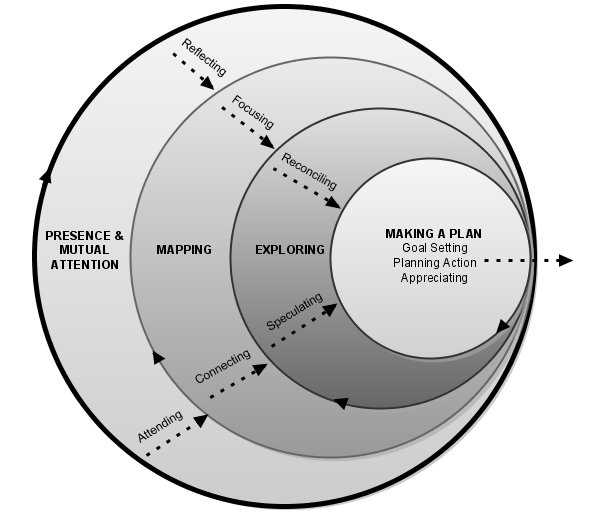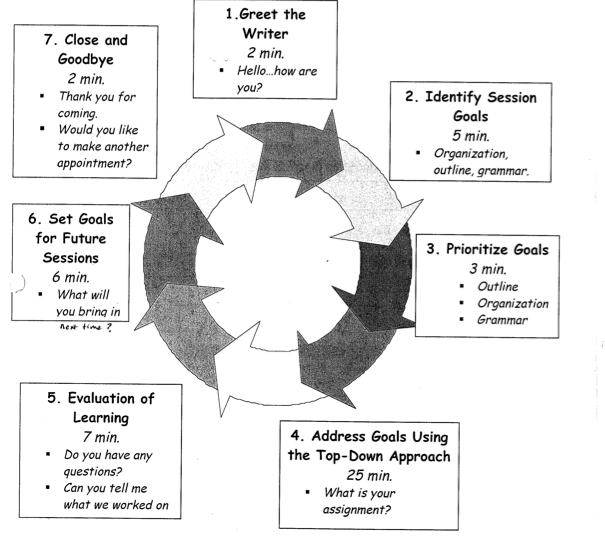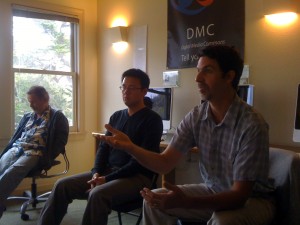“Our self-esteem emerges from contact with others who provide us with the five A’s. The five A’s are not extras. They are the components of the healthy, individuated ego: Attention from others leads to self-respect. Acceptance engenders a sense of being inherently a good person. Appreciation generates a sense of self-worth. Affection makes us feel lovable. Allowing gives us the freedom to pursue our own deepest needs, values, and wishes.” -From “How to Be an Adult in Relationships” by David Richo
On Friday October 1st, Peter Shaw and Bob Cole teamed up to offer the GWC, DMC, and TA teachers a workshop on the speaker-understander model, a model of communicating that embodies the 5 A’s postulated by David Richo above. As teachers, tutors, and mentors, the speaker-understander model forces us to do one of the most difficult things a person can do in communicating: intentional listening.
In the meeting, we did an exercise in which two people squared off: One played the role of speaker; the other was the understander. The speaker was to talk for three minutes about a work-related challenge while the listener…listened (This is much more difficult than it sounds!). Speakers noted how difficult it was to talk for that long without the other person interrupting. Listeners commented on their impulse to jump in. Both facts underline how conditioned we are to think about what we are going to say next rather than listen.
For teachers, tutors, and mentors, the model offers a chance for conscious interaction, listening to students before bringing out the first aid kit and getting to work fixing everything. Let’s first understand who we are working with and what they are truly saying about their challenges.
 Image and phases below based upon: Julian Edge, Cooperative Development, Harlow, UK: Longman, 1992. And Julian Edge, Further Cooperative Development, Ann Arbor, MI: University of Michigan Press, 2002.
Image and phases below based upon: Julian Edge, Cooperative Development, Harlow, UK: Longman, 1992. And Julian Edge, Further Cooperative Development, Ann Arbor, MI: University of Michigan Press, 2002.
As understanders, we follow four phases:*
Phase 1:
Attending: I am actively and supportively listening to you (Open gestures, nodding, back-channeling).
After actively listening, we reflect back and paraphrase what we’ve heard:
Reflective: If I understand what you’ve said correctly, you think…
Phase 2:
Focusing: What is the most important aspect? What do you want to concentrate on? What is your underlying assumption about this?
Thematatizing: Do you think there is a connection between A and B? What is the relationship between A and B?
Phase 3:
Reconciling: How does that fit with what you said about X?
Speculating: I am wondering…
Phase 4:
Goal Setting: So what might be the take away here?
Planning Action: So how might you go about this?
Appreciating: I really appreciate your…
The speaker-understander model closely parallels the tutor cycle that we use at the GWC:

In both models, we begin by listening. As tutors and teachers, we can learn to repeat back what we are hearing from students in order to clarify our understanding of their challenges. Moving further into the session, we begin focusing (phase 2 of the speaker-understander model), which may be similar to setting and focusing goals collaboratively with students in the tutor cycle model. In phase 3, we start getting into the “meat” of the issue, asking reconciliatory questions (ie: writer’s perceptions vs reader’s perceptions; speaker’s perceptions vs listener’s perceptions) and speculating. Finally, phase 4 of the speaker-understander model moves into goal setting and planning action, which ideally is how we would finish a writing tutoring session: “So…what did we talk about in today’s session? Where do you plan to take this paper? What can we expect from next session?”
There is a great deal of overlap between these two models and it seems we can borrow from both to inform our practices as mentors.
* Speaker-Understander Material relies heavily upon Bob Cole and Peter Shaw. 2009 POD Network Conference, Houston, TX: Edge Conversations in Professional Contexts.



